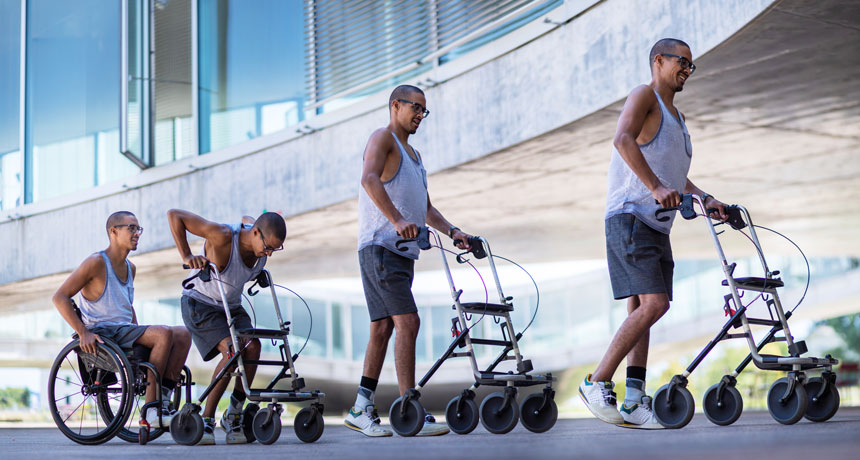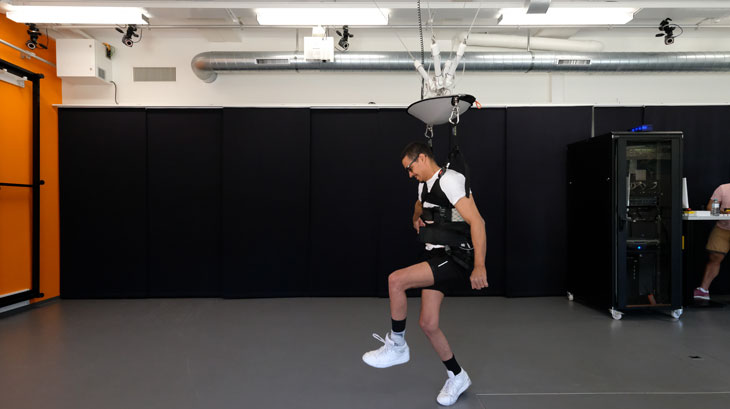Zaps to spinal cord help paralyzed people walk
The treatment strengthens communication between brain and spinal cord

David Mzee, 28, was paralyzed in 2010. He had five months of therapy that included electrical pulses to his spinal cord. With some help supporting his weight, Mzee (seen above in this composite image) now can walk for an hour at a time.
© JAMANI CAILLET/EPFL
For many people, paralysis used to be a life sentence. But that’s changing.
Injuries to the spinal cord can cause paralysis, an inability to move one or more parts of the body. But a new therapy may help when other treatments have failed. It stimulates the spinal cord with electricity.
A new study involved three people who had been paralyzed from very badly injured spinal cords. For five months, each underwent training. At the same time, researchers also zapped nerve cells in their spinal cords with electricity. Afterward, each person could walk with some support. The researchers described their results online October 31 in Nature.
Nerve cells are also called neurons. Jolting these cells in the spinal cord with electricity boosts signals coming from the lower limbs. This improves the brain, and legs communicate better.
All three patients were paralyzed from an injury at least four years earlier. Each still had some nerve connections at the site of their injuries. Even after a lot of therapy, though, none had gotten back any movement.
But after the therapy, two of the people could walk with crutches — now without electrical stimulation. That suggests the treatment may have helped strengthen links between the brain and spinal cord.
This kind of recovery is “extremely exciting,” says Chet Moritz. He works at the University of Washington in Seattle and wasn’t involved in the work. As a neuroscientist, he studies the nervous system, including the brain and spinal cord.
Precision pulses
Two other major studies had similar results. Each was published in September. Both showed similar recovery from paralysis. But in those studies, the people no longer had any working nerve connections between their spinal cords and leg muscles.
Showing that nerve zapping can help different types of patients “is really important,” says Susan Harkema. She’s a neuroscientist at the University of Louisville in Kentucky. In people with different types of long-term spinal cord injuries, “we’ve showed with training and stimulation, people … [can] recover,” says Harkema. She was a coauthor of one of those September studies. It appeared in the New England Journal of Medicine.
The treatment was a technological challenge, says Grégoire Courtine. A coauthor of the new study, he works at the Swiss Federal Institute of Technology in Lausanne. Like Harkema’s team, Courtine and his group put a machine into their patients’ bodies that emitted electrical pulses. The device was only as big as a matchbox. It was originally designed to treat pain.
Sending pulses of electricity to the spinal cord can trigger muscles to move. But earlier research had shown that different zapping patterns worked better for different movements (such as lifting a leg versus setting it down). So Courtine’s team didn’t make its stimulator run all the time. Instead, they designed a wireless system to control it. The device sent electrical pulses to specific groups of neurons at precise times. And those times could be set to match how patients wanted to move their muscles.
This targeted stimulation “takes [the therapy] to the next level,” Moritz says.
Constant stimulation also can interfere with how patients sense the position of their limbs in space. Courtine’s team reports that finding in a separate study. It was published October 31 in Nature Neuroscience. Feeling where limbs are in space is important for movements like walking, he notes. These movements need many muscle groups to work together. Targeting where the zaps occurred was better at improving movement in the patients they tested. It turned up the volume on talk between the limbs and the brain without didn’t drowning out feeling.

Remarkable recoveries
Patients who got the pulsed treatment had to learn how to coordinate their own movements with the stimulation. At first, a device helped people by holding up their trunk so they could stay upright. Within a week of starting this therapy, all three patients could walk as their spinal cords were being stimulated. After five months, two patients were able to walk hands-free when they were wearing a harness that supported 35 percent of their body weight. The third patient, who had more severe injuries, needed more help.
Two patients even became able to move with the electrical stimulation turned off. They could go from sitting to standing and walk short distances with crutches. The third patient could move his legs without stimulation.
Next, Courtine and his colleagues hope to test the technology in people with more recent injuries. After paralysis, muscles and nerves usually start to waste away. If doctors could start the treatment sooner, patients might make even greater recoveries.







